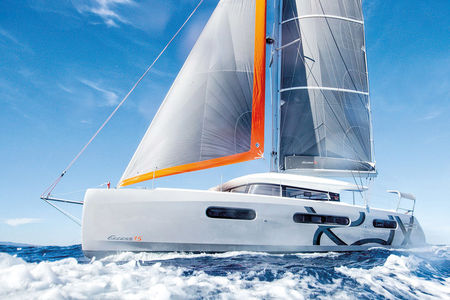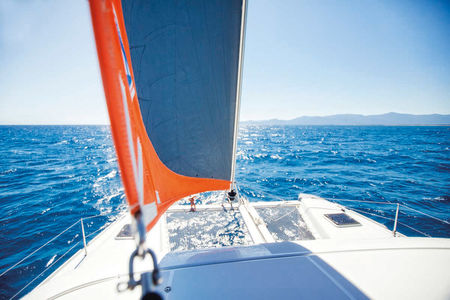
Issue #: 180
Published: November / December 2021
- Price per issue - digital : 6.50€Digital magazine
- Price per issue - print : 8.50€Print magazine
- Access to Multihulls World digital archives Digital archives
For this edition of the match, we interviewed two of the most renowned designers - Marc Van Peteghem of VPLP and Olivier Racoupeau of Berret Racoupeau Yacht Design. These two design firms represent over 10,000 multihulls built. Marc and Olivier are not 100% for or against the self-tacking jib sheeted on a transverse track, or the classic solent on a longitudinal track; the two naval architects have used both sail plans and fittings installed according to the specifications defined with the client or the brand. Since Lagoons and Excess catamarans are all fitted with self-tacking jibs, we asked Marc, who is responsible for all these plans, to argue this choice. As for Olivier, it’s up to him to defend the classic solent, since all the Fountaine Pajot models he’s designed feature an overlapping genoa.
FOR THE SELF-TACKING JIB - by Marc Van Peteghem

Marc Van Peteghem was the co-founder, with Vincent Lauriot-Prévost, of VPLP, which has been active in the yachting industry for four decades. The naval architecture firm based in Paris and Vannes, in southern Brittany, is the designer of the fastest multihulls, whether around the world or around the cans. Nevertheless, VPLP’s involvement in the cruising industry has been significant since 1987 with the Lagoon and Excess brands, having designed over 35 models.
Marc clearly recognizes that the aerodynamic performance of a self-tacking jib is not necessarily optimal. The sail lacks overlap and sometimes surface area, especially along the foot, which inevitably penalizes performance. For him, it’s all a question of balance and consistency between the actual use in daily practice and the design, including the overall geometry of the sail plan: “It’s interesting to define what boaters are looking for in terms of performance and comfort when cruising. I’m looking at this without compromising the speed potential, which could be the case with a more forward-set rig that drastically reduces the sail area of a self-tacking jib. And the answer come naturally: ease of handling is a major factor in the choice of a type of rig, and anyone who has ever tacked with such a setup can only agree. The sail flogs much less when being furled. From the moment we chose to center the rig by moving the mast further aft on the Lagoon range, the foretriangle, now enlarged, became conducive to fitting a 95% jib on a self-tacking track. The longer foot gives a more open triangulation to the sail, making it less pointy at the head, and the sail keeps its shape better. The fact that the track is installed higher up, on the coachroof, shortens the leech and gives the sail a cut which also makes trimming easier. The other key point is also the advent of sails with greater overlap, such as the gennaker, which are just as easy to handle. These sails mitigate any possible deficit when you need to bear off. In most cases we’ve simulated, this setup appears to us to be amply satisfactory for use in cruising, and is the least restrictive possible for the crew, while maintaining an acceptable level of performance for this type of sailing and for the users”.
 |
 |
FOR THE CLASSIC SOLENT - by Olivier Racoupeau

Olivier has been part of Berret Racoupeau Yacht Design for 30 years. The firm has put their signature to some of the most emblematic yachts in production, semi-custom or one off. Their collaboration with Fountaine Pajot began in 1991, and since then, more than thirty
models of this brand’s sailing catamarans have come off the drawing boards and computers of the La Rochelle-based firm.
Even though he might sometimes draw a deck plan with a selftacking track, for a staysail for example, Olivier has long preferred the low-overlapping solent. According to him, following testing in a virtual wind tunnel, ...
What readers think
Post a comment
No comments to show.